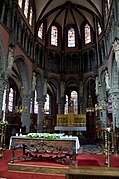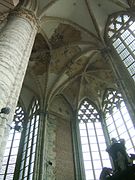Scheldt Gothic
The Scheldt Gothic is a regional early Gothic transition style from Romanesque to Gothic in church construction. It is named after the river Scheldt , which flows through northern France and Belgium.
The Scheldt Gothic as an architectural style
From the beginning of the 13th century, the Scheldt Gothic style adopted the Gothic style from the Ile de France and Burgundy in the construction of churches in the Scheldt Basin in Flanders . The main building material is the gray-blue limestone from Tournai , and brick in the coastal regions of Flanders . The church of Saint-Quentin in Tournai is considered to be the first work of the Scheldt Gothic style, construction of which began before 1200. That is why the Scheldt Gothic is referred to in French as "gothique tournaisien".
Mark
- The Scheldt Gothic differs from the Brabant Gothic , which is geographically to the east, but also temporally subsequent , in that it is more strict forms and the more economical use of ornaments.
- Scheldt Gothic churches typically have the tallest tower above the crossing , as found almost only in Romanesque in France and Germany, but in many Gothic churches in England and Spain. This crossing tower has four corner turrets and is vaulted in eight parts as a monastery dome .
- Round pillars lead into octagonal bud capitals .
- The services rest - at least until the middle of the 13th century - on consoles .
- An outside walkway runs along the upper storey .
- In Triforium themselves pillars and columns alternate.
- Some of the churches have small round or octagonal corner towers on the main nave or transept, as can also be found in Dutch buildings that are not attributed to it.
Exemplary buildings
Significant examples of the Scheldt Gothic are:
- in Aardenburg : Bavokerk (Sint-Baafskerk)
- in Bruges : St. Salvator's Cathedral
- in Damme : Onze-Lieve-Vrouwkerk
- in Ghent : Sint-Niklaaskerk
- in Lissewege : Onze-Lieve-Vrouwkerk
- in Oudenaarde : Onze-Lieve-Vrouwekerk
- in Tournai: the Tournai Cathedral and the Saint-Jacques church
- in Ypres : the Sint-Maarten cathedral (destroyed in the First World War)
St. Niklas Church in Ghent
covers

The Cathedral of Tournai is not a typical example, as are side by side with her Romanesque and Gothic parts of the building, Romanesque and Gothic style elements, but not integrated into one style.
The Scheldt Gothic influenced the “Paris” Gothic of the Île de France and Champagne, the development of brick Gothic in northern Germany and the southern Baltic region.
literature
- Section Scheldt Gothic . In: Wilfried Koch : architectural style. European architecture from antiquity to the present . Mosaik-Verlag, Munich 1982, ISBN 3-570-06234-1 , p. 178.






